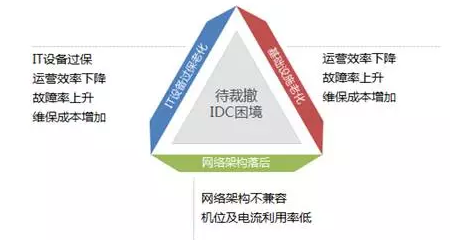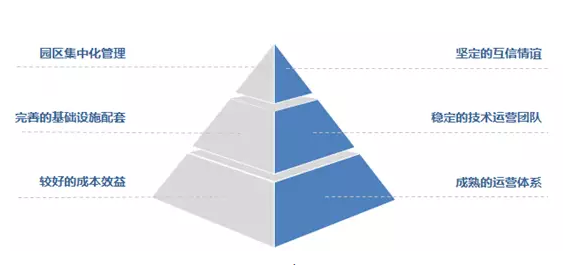The old tree sprouts new branches -- Thoughts on the management of the data center to be abolished
Time flies and technology takes off. The former giants are aging, looking back on their glory yesterday, American VPS Still brimming with pride. Standing at the crossroads of time, do you want to wave goodbye or look forward to new branches from old trees? - This is our thinking on the abolition of data center management.
1、 The challenges and opportunities faced by the data center to be abolished The operating life of the data center is usually 8 to 10 years. As time goes by, the data center infrastructure and equipment are aging, equipment stability is declining, failure rate is rising, equipment operating efficiency is declining, and maintenance costs are significantly increasing; IDC network architecture is difficult to meet the needs of current business development; IT equipment has passed the warranty, equipment failure rate has significantly increased, and the cost of renewal has increased.

Figure 1 Challenges of IDC to be eliminated
Although IDC to be abolished faces many problems and challenges, they also have many advantages that deserve attention. After nearly 10 years of data center operation, a relatively mature and complete operation system has been established; The operation team is relatively stable in terms of technology accumulation and echelon personnel training; What is more important is the steel like mutual trust that we have established with IDC operators for nearly 10 years.
Especially for large data center parks, there are the following advantages for the transformation of the data center to be abolished: it is conducive to centralized management and avoids fragmentation of the data center; The municipal infrastructure supporting construction of the large data center park has good resource input, especially the reliability and availability of external power supply and municipal water supply are high; The mature surrounding facilities of the data center park also help the stability of operators; The cost of large-scale data center transformation is low, the construction cycle is short, and the entire delivery cycle can be greatly shortened compared with relocation.

Figure 2 Advantages of IDC to be disabled
Therefore, in addition to comprehensive consideration of the hardware conditions such as the infrastructure of the data center to be abolished, the software advantages such as the operation system are also important contents for the data center manager to evaluate and manage the data center to be abolished.
2、 The transformation assessment of the data center to be abolished faces the demand of continuous business development, and the challenge to the existing old data center is increasingly severe. The transformation of the data center to be abolished may bring us new opportunities.
The service life of various equipment in infrastructure is different. For example, the design service life of high and low voltage distribution cabinets and transformers is usually 20 years; The design service life of the UPS system is usually 8-10 years (some parts may be replaced in advance, such as batteries and capacitors, which are usually replaced every five years). How to proceed with the evaluation of the transformation of the data center to be abolished?
1. Infrastructure reconstruction evaluation:
(1) Power distribution system: the capacity of the city is a key concern. With the development of IDC, the power consumption of a single cabinet continues to increase. In particular, MDC (micro module data center) can achieve 6.5~10kW of a single cabinet. The power capacity demand in the unit space will increase significantly.
The service life of high and low voltage distribution cabinets and transformers is usually 20 years. For IDC that has been put into operation for 8-10 years, this part can be considered to continue to be used, but it needs to conduct a comprehensive inspection and replace hidden equipment.
UPS system is mainly used in data centers that have been put into operation for 8-10 years. According to the life cycle of the UPS, the main body of the UPS has reached the retirement age, and the UPS battery and capacitor (usually replaced every five years) and other components have been replaced twice, and it is not recommended to retain them. At the same time, we can consider introducing HVDC systems with higher energy efficiency (two-way HVDC or HVDC+mains direct power supply).
(2) Air conditioning system: For the traditional air-cooled air conditioning system, the overall PUE of the machine room is relatively high, and the cooling effect is poor in the extreme climate of high temperature. If the space meets the requirements, it is recommended to update it to a water-cooled unit or configure it to a dual cooling source system. This will significantly improve the operation efficiency of the system and increase the robustness and reliability of the system.
For the water cooling unit system, under the condition of good maintenance, the core equipment of the chiller and water pump can still be used normally, but we need to fully evaluate their operating efficiency and replace the hidden parts. Pipeline system is a key link that needs to be paid attention to. Pipeline corrosion and valve corrosion will seriously threaten the system operation.
(3) Cabinet mode: the traditional data center of 8~10 years may adopt the then more advanced cabinet air supply and cold and hot channel isolation technology. Its refrigeration efficiency has greater room for improvement.
When the room space and bearing conditions are good, we suggest to consider using MDC technology. MDC technology can significantly improve the cooling efficiency, and realize the rapid delivery of racks in batches. It is the only choice to meet the needs of rapid business development.
When the floor height and bearing capacity of the machine room are limited, the cold and hot channel isolation technology can still play an important role.
(4) Other systems: For the fire protection system, compared with the gas fire protection system widely used in the data center of traditional operators, Tencent Data Center is committed to promoting the application of pre acting high-pressure water mist fire protection system (in the IT machine room). When faced with fire and other risks, Tencent Data Center always puts the life safety of operation and maintenance personnel first.
For the access control and monitoring system, it is necessary to consider whether the original access control and monitoring system can cover the new capacity expansion requirements after transformation, such as dynamic environment monitoring, group control, CCTV, MDC monitoring data docking, etc.
2. Evaluation of network architecture transformation:
(1) Network architecture: In order to meet the development needs of business, the network architecture is also changing with each passing day. Taking Tencent data center as an example, the traditional data center mainly adopts the gigabit network architecture, while currently we mainly build the 10 gigabit network architecture, and the equipment under the two architectures cannot be completely matched (usually 10 gigabit servers can be compatible with the gigabit network architecture, while gigabit servers cannot be compatible with the 10 gigabit network architecture). Therefore, we need to select the appropriate network architecture according to the current business needs.
(2) Stand launch standard: stand launch standard is a specification formulated in combination with network architecture, equipment power consumption, rack space and power capacity. The traditional rack is mainly 16A or 20A (single cabinet is less than 4.4kW), while Tencent IDC currently mainly uses 30A rack, so the shelf standard also needs to be updated.
3. Server evaluation: The update cycle of server technology is very fast. Generally, the life cycle of the server is 3-5 years. Servers that are in service life and conform to the new network architecture can continue to be relocated for use, and expired equipment can be updated and eliminated. In addition, the server has relatively good compatibility with AC and DC power distribution systems and refrigeration systems, which is usually not the bottleneck to decide whether the data center will go or stay.
4. Related business evaluation: for businesses with multi-point distribution, good business robustness, good risk resistance, and quick and flexible scheduling, and with urgent requirements for transformation time, not demanding requirements for infrastructure side robustness, but also pursuing operating costs. It can be considered that fast and low transformation cost should be selected, and moderately small machine rooms should be changed to "cheap" machine rooms for such businesses. (The "cheap" here has included the low maintenance investment in the reconstructed data center)
For businesses with weak business robustness and heavy reliance on infrastructure side robustness, high transformation investment can be considered, and moderately transformed into a highly reliable data center to meet business needs.
Of course, no matter what kind of business, we still need to consider the migration cost of the business comprehensively.
Concluding remarks
Data center retirement is an important part of data center lifecycle management. As time goes by, more traditional data centers will be retired. How to maximize the use of existing infrastructure conditions while meeting business development needs will be an important issue to test the management ability of data center managers (referred to as "data managers").
Today, we put forward this topic because we have just encountered this problem in the process of massive operations. What is the best way to do it? We have no answer at present. I hope we can discuss it with you more in the future. Of course, if we find out a little experience in the process of practice, we will also share it in time.
Old trees sprout new branches, counting classics in action!

